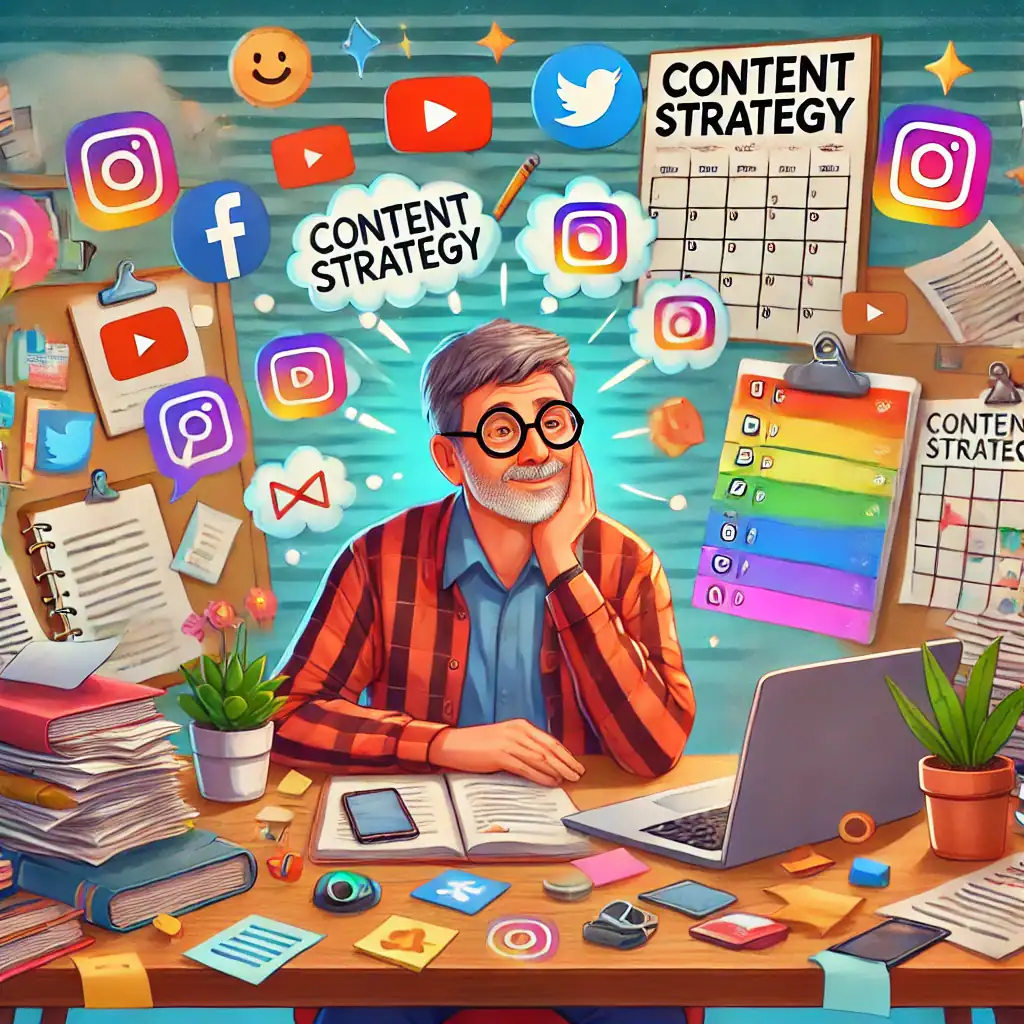A Beginner’s Roadmap to Success
Welcome to the exciting world of content strategy! If you’re completely new to this, don’t worry — you’re in the right place.
Content strategy might sound like a big, intimidating term, but at its core, it’s simply about creating a plan to share valuable information with the right audience in a way that benefits everyone. In this guide, I’ll break everything down step by step, so you can start building your own successful content strategy from scratch.
1. What is A Content Strategy?
1. What is Content Strategy?
Content strategy is a fancy way of saying, “Let’s make a plan for the stuff we post on our website and social media so it helps people and meets our goals.” It’s about creating and sharing content — like blogs, videos, social media posts, or emails — that connects with your audience and moves you closer to your objectives.
Here’s an example: Imagine you love baking. A content strategy for your baking blog might include sharing simple recipes, baking tips, or short how-to videos that teach people new skills while promoting your expertise.

Myth buster:
You don’t need to be a professional writer or tech wizard to create a successful content strategy. All you need is a bit of creativity and a clear plan.
2. Why Do You Need a Content Strategy?
Without a strategy, creating content can feel like throwing spaghetti at the wall to see what sticks. Here’s why having a plan is essential:
- Build trust: Consistent, valuable content shows your audience you’re reliable.
- Reach the right audience: A strategy helps you focus on people who care about your message.
- Achieve your goals: Whether you need more sales, website visitors, or social media engagement, content strategy gives you a roadmap.
Think of it this way: A good content strategy is like a recipe. You wouldn’t bake a cake without knowing what ingredients to use or how long to bake it. The same goes for creating and sharing content!
3. Understanding Your Audience (Your "Who")

The first step in content strategy is knowing your audience. Who are you trying to reach, and what do they care about?
How to identify your audience:
- Start with simple questions: “Who would benefit from my content? What problems do they have, and how can I help?”
- Use tools like surveys or casual conversations to gather insights.
Create an audience persona: This is like creating a character for your target audience. For example:
- Name: Sarah
- Age: 28
- Interests: Fitness, healthy recipes, quick meal prep tips
- Problem: Wants easy recipes for busy weekdays
You can make this persona as detailed as you can. Think about hobbies, family life, work, even physical attributes. Anything you can add to this persona will make it much easier to write to your audience.
Knowing your audience helps you create content that truly resonates.
4. Setting Your Goals (Your "Why")
Why are you creating content in the first place?
Setting clear goals will keep you focused and motivated.
Examples of beginner-friendly goals:
- Increase followers on Instagram by 100 in the next three months.
- Publish at least one blog post per week to grow website traffic.
- Share three helpful tips on social media each week to build engagement.
Pro tip: Make your goals SMART — Specific, Measurable, Achievable, Relevant, and Time-bound. For example, instead of saying “I want more followers,” say, “I want 100 new followers on Instagram in the next three months.”
5. Choosing Your Platforms (Your "Where")
Where should you share your content? The best platforms depend on your audience and goals.
Overview of popular platforms:
- Instagram: Great for visuals and quick updates.
- Blogs/Website: Perfect for long-form content like guides and articles.
- Email Newsletters: Useful for building a direct connection with your audience.
- YouTube/TikTok: Ideal for video content.
If you’re just starting out, pick 1-2 platforms where your audience is likely to be. For example, if your audience loves visual inspiration, Instagram or Pinterest might be a great starting point.
6. What Kind of Content Should You Create? (Your "What")
Creating content doesn’t have to be overwhelming. Start small and focus on what your audience needs.
Beginner-friendly content ideas:
- Social media posts: Share tips, fun facts, or behind-the-scenes photos.
- Simple blogs: Write about what you know, like a “How to” guide or a list of resources.
- Short videos: Use your phone to create quick tutorials or share a story.
Remember, quality beats quantity. One helpful post is better than five rushed ones.

7. How to Create a Simple Content Plan (Your "When")
A content calendar can make your life so much easier. It helps you stay organized and consistent.
Steps to create a content plan:
- Decide how often you’ll post. Start with something manageable, like 1-2 posts per week.
- Plan your topics in advance. For example, “Monday: Share a recipe, Thursday: Post a baking tip.”
- Use free tools like Google Calendar or Trello to organize your schedule.
Consistency is key. Even a small, steady effort can lead to big results over time.
8. Measuring Your Success (Your "How")
How do you know if your content strategy is working? Measuring your results will help you learn and improve.
Track these simple metrics:
- Engagement: Likes, comments, shares.
- Traffic: How many people visit your website or click on your links.
- Followers: Growth on social media.
Most platforms offer basic analytics tools, like Google Analytics, to help you see what’s working and what’s not.
9. Overcoming Common Beginner Challenges
Starting something new can feel daunting, but here’s how to tackle common hurdles:
- “I don’t have time”: Schedule your content creation in small chunks. Even 30 minutes a week can make a difference.
- “I’m not creative enough”: Look for inspiration online and use free tools like Canva to create eye-catching designs.
- “No one’s engaging with my content”: Stay patient. Focus on providing value, and the engagement will come with consistency.
And Finally...
Remember, every expert was once a beginner. Content strategy is a skill you build over time. Start small, stay consistent, and don’t be afraid to experiment. The key is to keep learning and adapting as you go.
Your first steps:
- Define your audience.
- Choose a platform.
- Post your first piece of content.
You’ve got this!
Bonus Resources
Your Content Creation Checklist. Click Here.
For more information on content strategy, check these resources:
-
Google Search Central – SEO Starter Guide
-
Includes advice on how content structure and SEO work together—useful for beginners planning their strategy.
-
-
Wealthy Affiliate – Free Starter Membership
-
Ideal for beginners wanting to create a blog or online business with step-by-step training on content and SEO.
-
Here’s a little transparency: My website contains affiliate links. This means if you click and make a purchase, I may receive a small commission. Don’t worry, there’s no extra cost to you. It’s a simple way you can support my mission to bring you quality content.”

